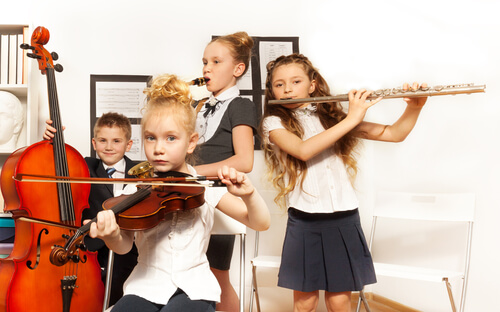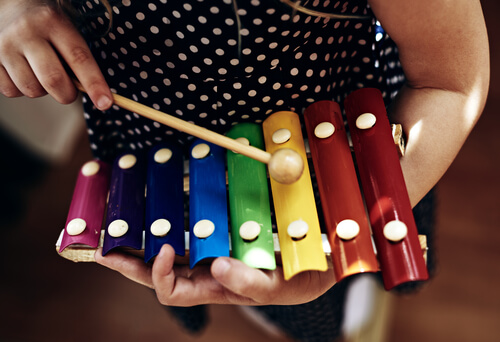Classical Music for Children: What to Listen to

Rhythm right from the mother’s womb. Many moms play classical music for their baby during pregnancy, as both can benefit from its effects.
Babies have the ability to hear from the 20th week of pregnancy. From that moment on, the music positively affects their circulatory system, stimulates cells and favors brain development.
As far as the mother is concerned, the music creates favorable moods that the baby can perceive. When the mother relaxes and listens to music, concentrating on her breathing, her heartbeat will stimulate the baby.
Why classical music for children?
Some studies claim that classical music is beneficial for children in many ways, right from their early years. Most of these benefits are related to areas of the brain that are stimulated due to the type of rhythms and composition.
Some of those benefits in children are the following:
- Stimulates positive emotions
- Increases concentration and attention
- Stimulates creativity
- Increases math skills
- Helps expression
- Develops body expression
- Favors social interaction
- Stimulates the creation of memories, which subsequently increases the intellectual capacities
- Reduces stress and anxiety levels
- Reduces any existing pain
- Helps the child develop discipline and responsibility if, in addition to listening to music, they also play an instrument

When the children are involved in a formal study of music, there are other benefits such as improved reading skills and IQ. Music even has therapeutic effects in problems such as dyslexia.
The type of classical music for children depends on what you want to stimulate
Teachers, musicians and parents have studied the effects of music on children. They have reached some interesting conclusions about which music to listen to, depending on the instrument that predominates:
String instruments: Improves concentration when studying.
Percussion: Develops gross motor skills, as it stimulates the child’s whole body.
All types of classical music: Due to its complex structure, listening to it introduces the child to emotions and language structure.
What to listen to?
For babies:
- The classic Brahm’s Lullaby
- Nocturne No. 2 of Chopin
- The Concerto for Clarinet and the Piano Concertos no. 21 and 23, and the Second Movement of Mozart’s Concerto for Violin No. 3
- Orchestral Air Suite No. 3 by Bach
- Für Elise, Clair de Lune and Sonata no. 8 in C minor of Beethoven
- The Adagio of Albinoni
These are pieces whose composition, harmony and beauty are highly relaxing. They will help regulate the baby’s heart rate and calm him down, helping him fall asleep more easily.
To concentrate
In older children, the above list can be used for studying. Another option is the First Movement of the Piano Sonata in D major K.448 by Mozart. As is the Sonata for Piano No.11, K 331, III Alla Turca and Sonata No. 15, K. 545, also by Mozart.
To play and move around
The First Movement of Vivaldi’s Spring or the Third Movement of Summer are very good options for playtime, as they are pieces that give vigor, enthusiasm and joy. Another happy and dynamic option is Brahms’ Hungarian Dance No. 1.
We can also include the Concerto for Flute BWV 1044 Allegro by Bach on this list. The Sonata No.12 in F Major by Mozart is another excellent option.
To play or run
There are many examples of very dynamic pieces of music and compositions. This is the case of the Radetzky March Op. 228 by Johann Strauss, March of Pomp and Circumstance, # 1 Op.39 by Edward Elgar.

Music for sensitive children
Tchaikovsky’s Sleeping Beauty is a classic and its beauty is captivating, especially for the most sensitive and dreamy children. There is also Clair de Lune by Debussy, among other greatly popular pieces of music.
Other options
The list of classical pieces will be as varied and extensive as the musical tastes of the parents and other influential figures in the children’s lives.
These people are responsible for bringing the children into contact with classical music for the first time. Little by little, the children will develop their own tastes, preferences and favorite pieces.
If parents aren’t too knowledgeable about the genre, there are lists on the Internet that can be very helpful. You only need to put something like “classical music for children” or “classical music for babies” into your search engine and then browse the results.
You can also choose artists who present classical music in a more contemporary style. Vanessa Mae, Yiruma, Lindsey Striling, The Piano Guys, Two Cellos, are some of the most popular in this genre.
All of these are excellent options, even for ourselves. Their music is really amazing!
Many of these wonderful pieces are available online on different audiovisual platforms. The content is available to everyone, at no cost, and so we no longer have any excuse not to turn to these classic pieces that will bring us so many wonderful benefits as we bring up our children.
All cited sources were thoroughly reviewed by our team to ensure their quality, reliability, currency, and validity. The bibliography of this article was considered reliable and of academic or scientific accuracy.
- Anchundia, P. S. J., Cedeño, B. S. R., Anchundia, J. L. J., & Gavilánes, A. E. P. (2021). La música en los procesos motivacionales del aprendizaje en estudiantes de educación general, básica, nivel superior. Cuadernos de Educación y Desarrollo, 13(3), 114-129. https://dialnet.unirioja.es/servlet/articulo?codigo=8978347
- Bouloukou, F. (2022). Adaptación curricular para trabajar la dislexia en educación primaria a través de la música [Doctoral dissertation, Universidad de Córdoba]. Repositorio Helvia. https://helvia.uco.es/xmlui/handle/10396/23195
- Carrión, R. G., Arza, N., & Marauri, J. (2022). Tertulias musicales dialógicas. Revista Padres y Maestros (389), 47-53. https://revistas.comillas.edu/index.php/padresymaestros/article/view/17922
- Fernandez, N. B., Trost, W. J., & Vuilleumier, P. (2019). Brain networks mediating the influence of background music on selective attention. Social Cognitive and Affective Neuroscience, 14(12), 1441-1452. https://academic.oup.com/scan/article/14/12/1441/5716608?login=false
- François, C. (2019). La relevancia de la música en el desarrollo lingüístico de los bebés. Llengua, Societat i Comunicació, 17. https://hal.science/hal-02447007/
- Gillanders, C., Díaz, M. Á. T., & Mera, J. A. C. (2019). Música y emociones: pautas para su inclusión en la formación inicial del profesorado de infantil y primaria. Hekademos: Revista Educativa Digital, (26), 48-57. https://dialnet.unirioja.es/servlet/articulo?codigo=6985277
- Holler, A., & Gogolewska, M. Cómo los niños y las niñas experimentan la música clásica. Instituto Central Internacional para la Juventud y la Televisión Educativa (IZI). TELEVIZION, 25-29. https://izi.br.de/spanish/televizion/35-2022-S/35_2022_S.html
- Jiménez, D. N. E. Capítulo 5 Desarrollo afectivo del alumno de preescolar a través de la educación musical: Una perspectiva de la educadora. Handbook T-II, 40. https://www.ecorfan.org/handbooks_desafios_contemporaneos2.php
- Putkinen, V., Huotilainen, M., & Tervaniemi, M. (2019). Neural encoding of pitch direction is enhanced in musically trained children and is related to reading skills. Frontiers in Psychology, 10, 1475. https://www.frontiersin.org/articles/10.3389/fpsyg.2019.01475/full
- Rodríguez, I. K. A. (2021). La música clásica para mejorar la atención en los niños y niñas de inicial II, de la Unidad Educativa Cristiana Verbo, Chimborazo, periodo 2019-2020 (tesis de grado, Universidad Nacional de Chimborazo). Repositorio Digital UNACH. http://dspace.unach.edu.ec/handle/51000/7482
- Soles, E. G. R., Porto, M. D. M., & Incalla, D. P. (2022). La música: su importancia “inadvertida” para el desarrollo del niño. Paidagogo, 4(1), 62-73. https://educas.com.pe/index.php/paidagogo/article/view/102
- Welch, G. F., Biasutti, M., MacRitchie, J., McPherson, G. E., & Himonides, E. (2020). The impact of music on human development and well-being. Frontiers in Psychology, 11, 1246. https://www.frontiersin.org/articles/10.3389/fpsyg.2020.01246/full
This text is provided for informational purposes only and does not replace consultation with a professional. If in doubt, consult your specialist.
